The CLAT exam is divided into three different sections and Quantitative Techniques is one of them. This section refers to problem-solving and numerical questions. If you have no idea about the questions in the exam or want to master the section with versatile questions, use the CLAT Quantitative Techniques practice test on our educational website, SelfStudys.
Using this preparatory resource, you will have an idea of the types of questions, the marking scheme, and the duration. This test closely resembles the actual exam, helping you to develop your skills to tackle the exam efficiently within the allotted hours. Whether you have just started preparing for the exam or are in the middle of the preparation, our advice for you is to attempt the practice test on Quantitative Techniques for CLAT.
Quick Guide To Practice Test On Quantitative Techniques For CLAT
We have mentioned the key information of the CLAT Quantitative Techniques practice test online in the table below so that you can learn about its aspects.
| Aspect | Information |
|---|---|
|
Mode |
Computer-based |
|
Standard of Questions |
10th to 12th standard |
|
Questions Pattern |
MCQ (Multiple-Choice Questions) |
|
Duration |
10 minutes |
|
Maximum Marks |
10 |
|
Marking scheme |
|
|
Rank Criteria |
Depending on the time consumed to finish the test and the scored marks |
|
Types of questions |
Numerical and Problem-solving questions (Data Interpretation, Basic Algebra, Ratio & Proportion, Statistics & Estimation, Mensuration, and Arithmetic) |
Chapter-wise CLAT Quantitative Techniques Practice Test Online
You can efficiently strengthen your skills in solving multiple types of mathematical questions and other problems by using the chapter-wise CLAT Quantitative Techniques practice test with answers. The questions are organized by chapters to enable your mastery of quantitative techniques. Start practicing with these tests by pressing any of the tabs lined up below.
CLAT Quantitative Techniques Practice Test With Answers
The CLAT Quantitative Techniques practice test free is provided with the solutions on our website. Once you’re done answering the questions, you can find them after submitting the test. Each of the answers has been explained to make you understand the problems clearly and precisely. You can figure out your level of accuracy and errors with the help of these solutions as well as correct your mistakes.
How To Attempt The CLAT Quantitative Techniques Practice Test Free On Our Website?
The essential steps to attempt the Quantitative Techniques practice test online for CLAT on our digital platform are as follows:
- First and foremost, search “SelfStudys” on Google or any of the other search engines that you commonly use.
- Once you land on our homepage, you are supposed to click the menu icon.

- By hitting the menu button, you will be provided with a list of study materials. Here, you need to navigate to the CLAT section.
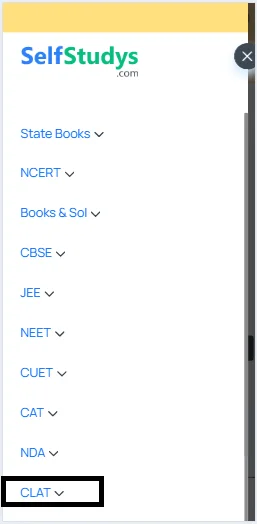
- Soon after accessing the section “CLAT”, you need to choose the CLAT Chapter-wise practice test.
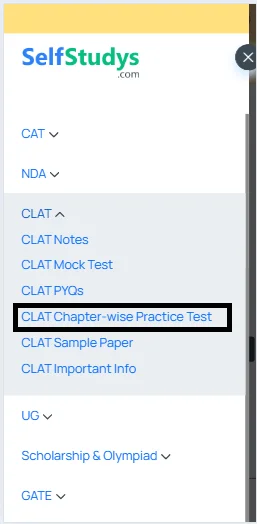
- Next, you will come across the tabs specified by various sections and you are advised to open the CLAT Quantitative Techniques practice test.
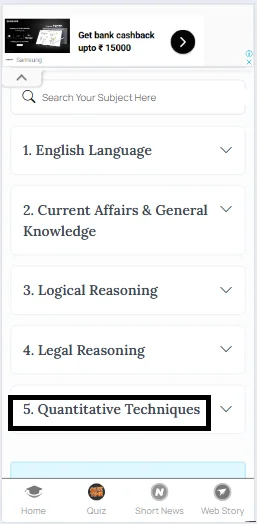
- Now, you should choose any of the chapters listed under the practice test on Quantitative Techniques for CLAT.
Note: Sign up or log in to our portal is mandatory to obtain the CLAT Quantitative Techniques practice test online result.
Understand The Key Topics Of Quantitative Techniques Practice Test Online For CLAT
By looking into the brief on the key topics covered in the CLAT Quantitative Techniques practice test with answers, it will be convenient for you to attempt the MCQs. All the topics are outlined in the table below.
| Chapter | Brief Description |
|---|---|
|
Average |
A value that is calculated by dividing the sum of numbers by the total count is called the average. |
|
Calendar |
Calculation between dates, years, weeks, and leap years. |
|
Time and work |
Calculate the time consumed for the same task by an individual or group. |
|
Squares, Square Roots, Cubes, Cube Roots |
Square refers to the multiplication of a number by itself once. The cube of a number means multiplying the number itself twice. The Square root is a square number. The cubed number is called the Cube root. |
|
HCF and LCM of Numbers |
HCF (Highest Common Factor) The largest common number is a divisor of two or more given numbers without a remainder. LCM (Least Common Multiple) The smallest common number which is a multiple of more than two numbers is the Least Common Multiple. |
|
Power And Index |
The power is an exponential value, where the index decides the number of times the number is multiplied by itself. |
|
Mixture And Alligation |
The concept is used to find the ratio and cost of the combined elements. |
|
Profit And Loss |
The chapter is based on the income statement concept. Define: The profit increases as the selling prices are higher than the cost price. |
|
Partnership |
The concept is all about understanding the profit and loss distribution among individuals based on capital amounts. |
|
Ratio And Proportion |
It refers to the quantitative comparison of two similar kinds, indicating one of them is relative to the other. A: B or A/B, are the two expressions used to represent them. |
|
Ages |
This chapter is all about calculating the age of an individual varied by different points in time. Algebraic equations are applied to express them, determining their past, present, or future age based on the restricted conditions. |
|
Data Interpretation |
The method of analyzing the numerical information and presenting it in a meaningful way using graphs, charts, or tables is referred to as Data Interpretation. |
|
Unitary Method |
A procedure solves the problem with the calculation of the value in a single unit and then using it to calculate the value of multiple units. The Unitary Method is based on Direct variation and Inverse variation. |
|
Percentage And Its Applications |
The fractional representation of numbers. This mathematical concept is used in statistics, finance, and competitive exams. |
|
Boats And Streams |
Here, in this chapter, you need to solve the problem; calculate the boat speed between the still and streaming water. |
|
Surds |
The chapter is based on irrational numbers at are impossible to express exactly as the fractional numbers. However, these are expressed in square roots, cube roots, and other higher roots. |
|
Simplification |
It refers to the concept of applying the BODMAS rule to simplify numerical expressions. Fractions, decimals, basic arithmetic operations, and approximation are the other rules included in the chapter to solve the mathematical questions. |
|
Decimals |
Decimal points differentiate the numbers, including whole numbers, in addition to fractional parts are called decimal numbers. |
|
Simple Interest And Compound Interest |
The extra amount paid or earned on a loan is termed interest. It has two major classifications, i.e., compound interest and simple interest. |
|
Time, Speed, And Distance |
It refers to a useful concept used in simplifying the problems related to motion. |
|
Statistics |
It refers to a field of study that deals with the analysis, organization of data, collection, presentation, and interpretation. Formulas like Mean, Median, and Mode are used to detail different statistical measures like financial trends, business performances, population data, and other relevant areas. |
|
Mensuration |
It refers to the process of calculating the perimeter, surface area, volume, and area. |
|
Geometry, Tables & Graphs |
Geometry refers to the formulas dealing with the shapes, sizes, and properties of figures in space. Tables refer to the merging of rows and columns. Graphs are the representation of data |
Why Is The CLAT Quantitative Techniques Practice Test Important?
The CLAT Quantitative Techniques practice test free helps you in many ways throughout the exam preparation to successfully achieve proficiency. The reasons behind attempting the test are listed below.
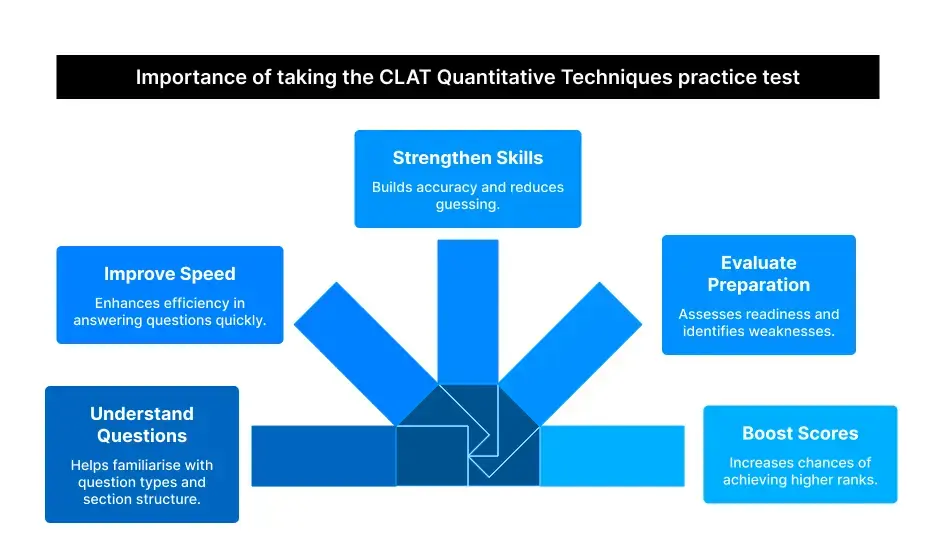
- Understanding the section and questions is the most specific reason for choosing the Quantitative Techniques practice test online for CLAT. By reviewing the entire section chapter-wise, you will have good practice with a variety of questions asked in the exam.
- The CLAT Quantitative Techniques practice test significantly helps in improving your speed, which is beneficial for you to answer most questions efficiently in less than a minute and submit the test within the allotted duration.
- You should include the practice test on Quantitative Techniques for CLAT to strengthen your skills in solving various styles of questions. This is how your accuracy will improve. Also, you do not need to answer any questions by guessing.
- The CLAT Quantitative Techniques practice test online lets you evaluate your preparation level. With this, you can continue your exam preparation, focusing especially on your weaknesses.
- In addition to the assessment of your preparation level, regularly solving the CLAT Quantitative Techniques practice test with answers is helpful to boost your scores and increase your chances of success.
Practice Test On Quantitative Techniques For CLAT: Effective Tips To Master
You need to use the CLAT Quantitative Techniques practice test free effectively to improve your performance. The effective tips for using the test papers and master each section are as follows:
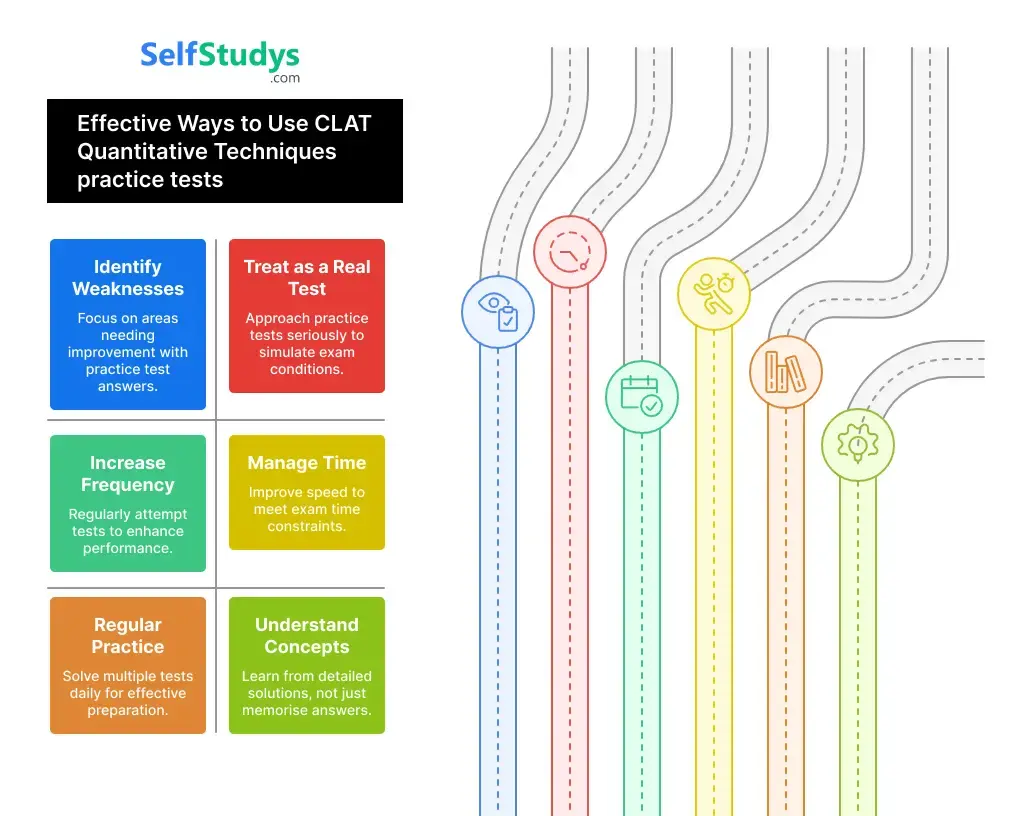
- Focus on identifying and improving your weaknesses with the help of the Quantitative Techniques practice test online for CLAT.
- Don’t take the CLAT Quantitative Techniques practice test for granted. You should suppose you are sitting for the real test.
- You should check your performances to work on them accordingly by increasing the frequency of attempting the practice test on Quantitative Techniques for CLAT.
- You should take care of the time when attempting the Quantitative Techniques practice test online. So that you can improve your speed accordingly and complete the test on time.
- The most traditional way to make the preparation effective is through regularity. If you want your performance to be enhanced, then solve 4-5 CLAT Quantitative Techniques practice test online as well as CLAT mock tests daily.
Conclusion
The Quantitative Techniques practice test online for CLAT is effective study material that simplifies your task for revision. All the essential chapters for the exam are covered through the practice test, along with the correct answers. You can access the answers through the results by ending the test and submitting it. Whether you want to evaluate your readiness or strengthen all the required skills to pass the exam, start attempting the practice test as soon as possible.







 Profile
Profile Signout
Signout














 Quiz
Quiz
 Get latest Exam Updates
Get latest Exam Updates 










